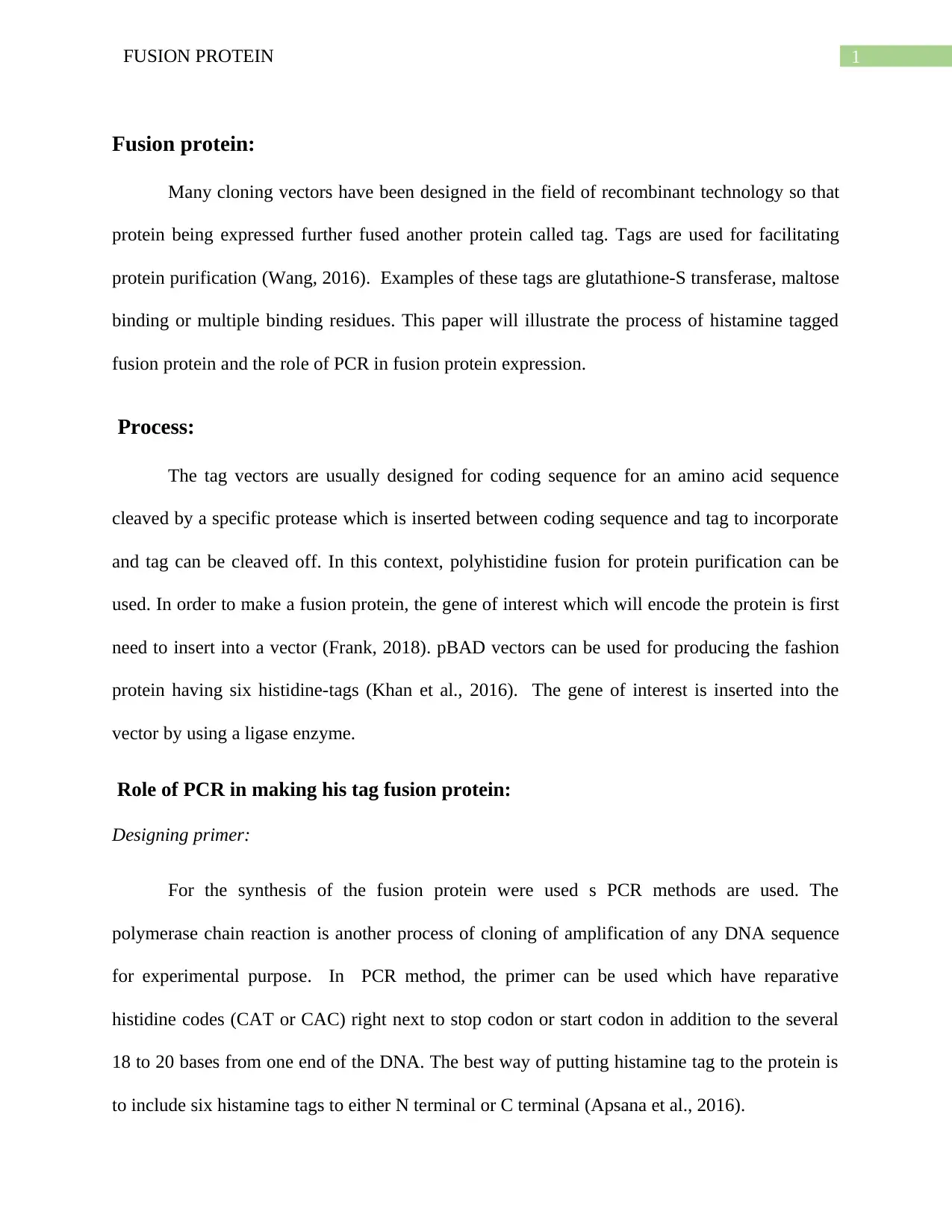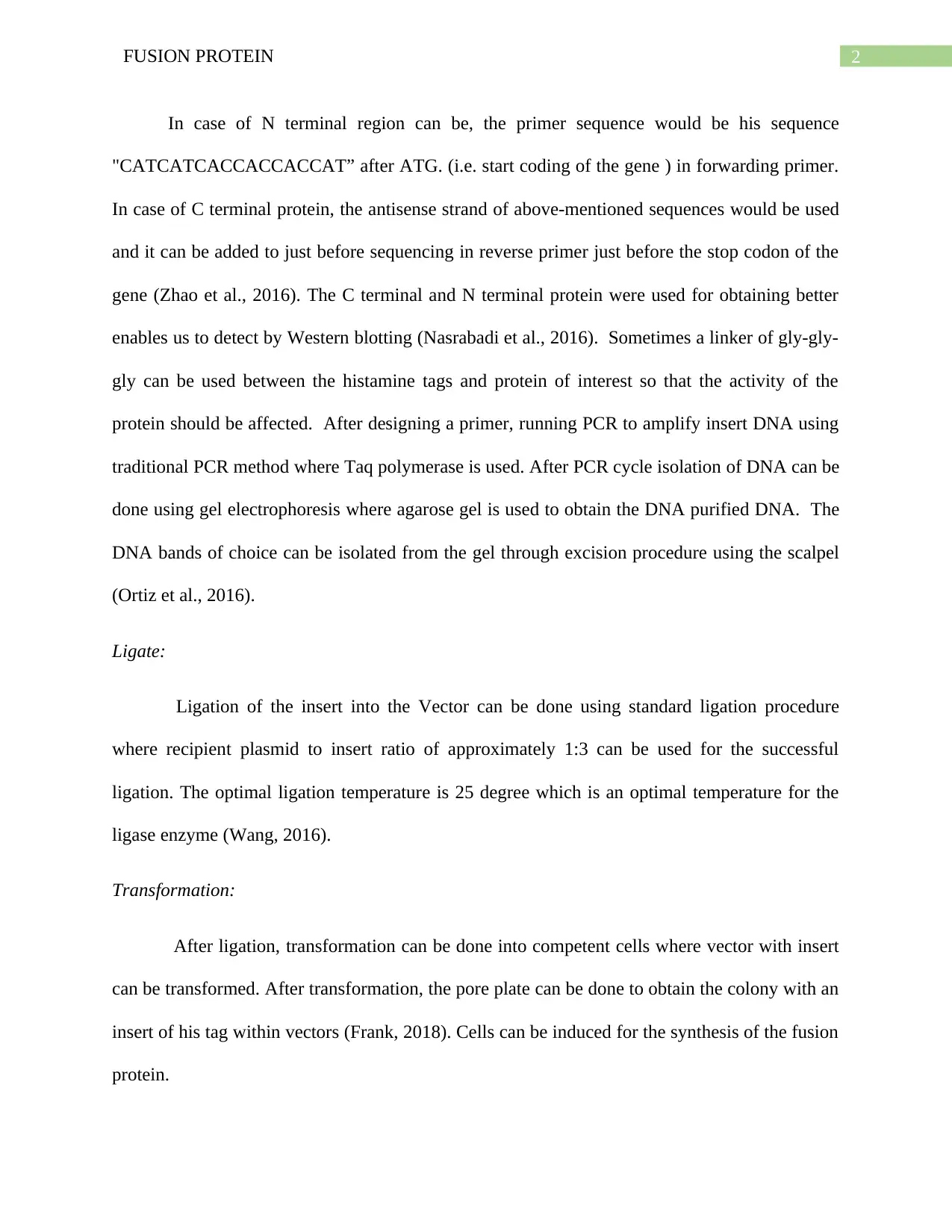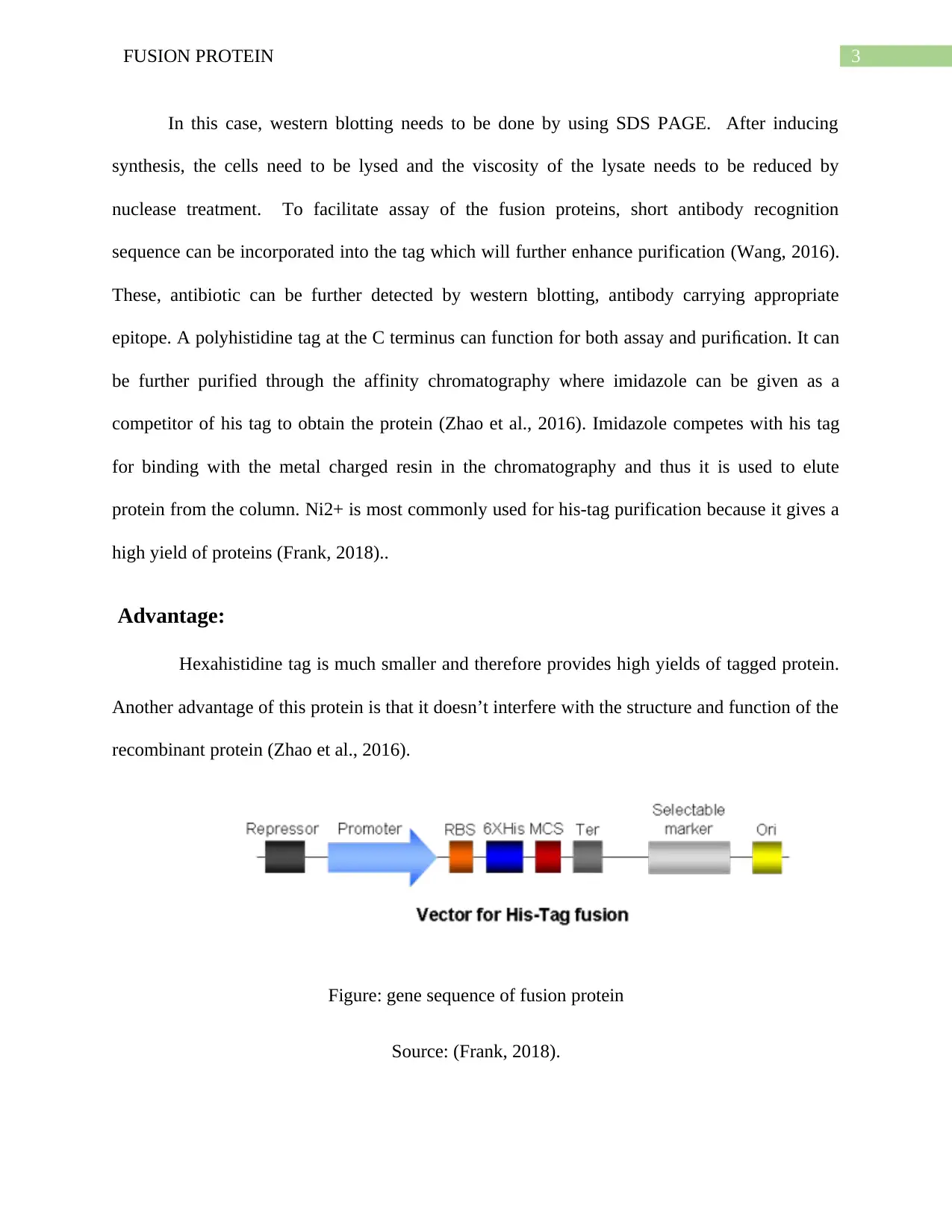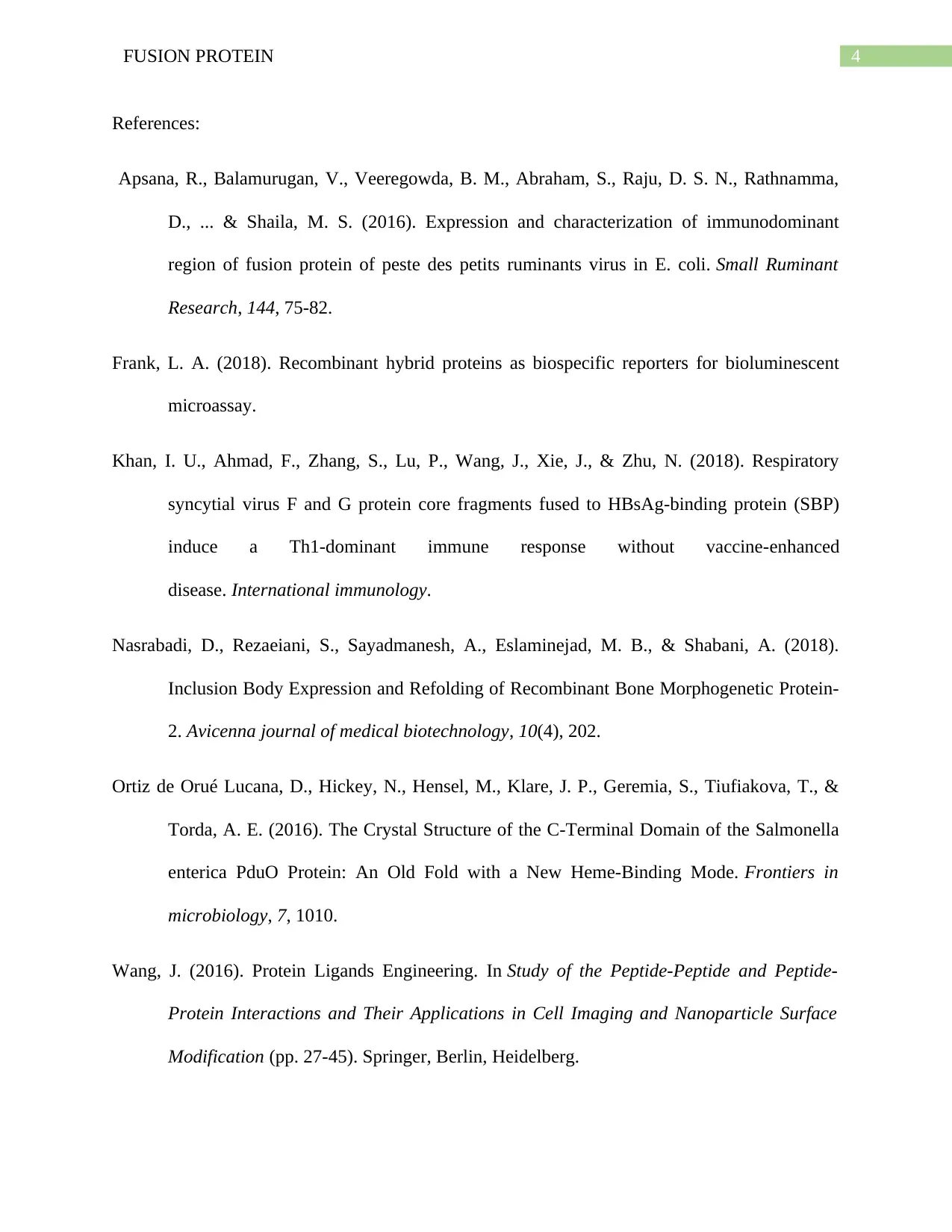Fusion Protein Synthesis: His-Tagging and PCR Amplification Process
VerifiedAdded on 2023/04/20
|6
|1270
|90
Report
AI Summary
This report elucidates the production of fusion proteins using polyhistidine tags for purification, emphasizing the role of PCR in gene amplification and primer design. The process involves inserting a gene of interest into a vector, designing primers with histidine codes for N or C-terminal tagging, and employing PCR for DNA amplification. Subsequent steps include ligation, transformation into competent cells, and induction of fusion protein synthesis. Western blotting and affinity chromatography are used for protein detection and purification, with imidazole serving as a competitor for his-tag binding. The advantages of hexahistidine tags include their small size and minimal interference with protein structure and function. Desklib offers a wealth of resources, including similar solved assignments and past papers, to aid students in their studies.

Running head: FUSION PROTEIN
Fusion protein
Name of the student:
Name of the university:
Author note:
Fusion protein
Name of the student:
Name of the university:
Author note:
Paraphrase This Document
Need a fresh take? Get an instant paraphrase of this document with our AI Paraphraser

1FUSION PROTEIN
Fusion protein:
Many cloning vectors have been designed in the field of recombinant technology so that
protein being expressed further fused another protein called tag. Tags are used for facilitating
protein purification (Wang, 2016). Examples of these tags are glutathione-S transferase, maltose
binding or multiple binding residues. This paper will illustrate the process of histamine tagged
fusion protein and the role of PCR in fusion protein expression.
Process:
The tag vectors are usually designed for coding sequence for an amino acid sequence
cleaved by a specific protease which is inserted between coding sequence and tag to incorporate
and tag can be cleaved off. In this context, polyhistidine fusion for protein purification can be
used. In order to make a fusion protein, the gene of interest which will encode the protein is first
need to insert into a vector (Frank, 2018). pBAD vectors can be used for producing the fashion
protein having six histidine-tags (Khan et al., 2016). The gene of interest is inserted into the
vector by using a ligase enzyme.
Role of PCR in making his tag fusion protein:
Designing primer:
For the synthesis of the fusion protein were used s PCR methods are used. The
polymerase chain reaction is another process of cloning of amplification of any DNA sequence
for experimental purpose. In PCR method, the primer can be used which have reparative
histidine codes (CAT or CAC) right next to stop codon or start codon in addition to the several
18 to 20 bases from one end of the DNA. The best way of putting histamine tag to the protein is
to include six histamine tags to either N terminal or C terminal (Apsana et al., 2016).
Fusion protein:
Many cloning vectors have been designed in the field of recombinant technology so that
protein being expressed further fused another protein called tag. Tags are used for facilitating
protein purification (Wang, 2016). Examples of these tags are glutathione-S transferase, maltose
binding or multiple binding residues. This paper will illustrate the process of histamine tagged
fusion protein and the role of PCR in fusion protein expression.
Process:
The tag vectors are usually designed for coding sequence for an amino acid sequence
cleaved by a specific protease which is inserted between coding sequence and tag to incorporate
and tag can be cleaved off. In this context, polyhistidine fusion for protein purification can be
used. In order to make a fusion protein, the gene of interest which will encode the protein is first
need to insert into a vector (Frank, 2018). pBAD vectors can be used for producing the fashion
protein having six histidine-tags (Khan et al., 2016). The gene of interest is inserted into the
vector by using a ligase enzyme.
Role of PCR in making his tag fusion protein:
Designing primer:
For the synthesis of the fusion protein were used s PCR methods are used. The
polymerase chain reaction is another process of cloning of amplification of any DNA sequence
for experimental purpose. In PCR method, the primer can be used which have reparative
histidine codes (CAT or CAC) right next to stop codon or start codon in addition to the several
18 to 20 bases from one end of the DNA. The best way of putting histamine tag to the protein is
to include six histamine tags to either N terminal or C terminal (Apsana et al., 2016).

2FUSION PROTEIN
In case of N terminal region can be, the primer sequence would be his sequence
"CATCATCACCACCACCAT” after ATG. (i.e. start coding of the gene ) in forwarding primer.
In case of C terminal protein, the antisense strand of above-mentioned sequences would be used
and it can be added to just before sequencing in reverse primer just before the stop codon of the
gene (Zhao et al., 2016). The C terminal and N terminal protein were used for obtaining better
enables us to detect by Western blotting (Nasrabadi et al., 2016). Sometimes a linker of gly-gly-
gly can be used between the histamine tags and protein of interest so that the activity of the
protein should be affected. After designing a primer, running PCR to amplify insert DNA using
traditional PCR method where Taq polymerase is used. After PCR cycle isolation of DNA can be
done using gel electrophoresis where agarose gel is used to obtain the DNA purified DNA. The
DNA bands of choice can be isolated from the gel through excision procedure using the scalpel
(Ortiz et al., 2016).
Ligate:
Ligation of the insert into the Vector can be done using standard ligation procedure
where recipient plasmid to insert ratio of approximately 1:3 can be used for the successful
ligation. The optimal ligation temperature is 25 degree which is an optimal temperature for the
ligase enzyme (Wang, 2016).
Transformation:
After ligation, transformation can be done into competent cells where vector with insert
can be transformed. After transformation, the pore plate can be done to obtain the colony with an
insert of his tag within vectors (Frank, 2018). Cells can be induced for the synthesis of the fusion
protein.
In case of N terminal region can be, the primer sequence would be his sequence
"CATCATCACCACCACCAT” after ATG. (i.e. start coding of the gene ) in forwarding primer.
In case of C terminal protein, the antisense strand of above-mentioned sequences would be used
and it can be added to just before sequencing in reverse primer just before the stop codon of the
gene (Zhao et al., 2016). The C terminal and N terminal protein were used for obtaining better
enables us to detect by Western blotting (Nasrabadi et al., 2016). Sometimes a linker of gly-gly-
gly can be used between the histamine tags and protein of interest so that the activity of the
protein should be affected. After designing a primer, running PCR to amplify insert DNA using
traditional PCR method where Taq polymerase is used. After PCR cycle isolation of DNA can be
done using gel electrophoresis where agarose gel is used to obtain the DNA purified DNA. The
DNA bands of choice can be isolated from the gel through excision procedure using the scalpel
(Ortiz et al., 2016).
Ligate:
Ligation of the insert into the Vector can be done using standard ligation procedure
where recipient plasmid to insert ratio of approximately 1:3 can be used for the successful
ligation. The optimal ligation temperature is 25 degree which is an optimal temperature for the
ligase enzyme (Wang, 2016).
Transformation:
After ligation, transformation can be done into competent cells where vector with insert
can be transformed. After transformation, the pore plate can be done to obtain the colony with an
insert of his tag within vectors (Frank, 2018). Cells can be induced for the synthesis of the fusion
protein.
⊘ This is a preview!⊘
Do you want full access?
Subscribe today to unlock all pages.

Trusted by 1+ million students worldwide

3FUSION PROTEIN
In this case, western blotting needs to be done by using SDS PAGE. After inducing
synthesis, the cells need to be lysed and the viscosity of the lysate needs to be reduced by
nuclease treatment. To facilitate assay of the fusion proteins, short antibody recognition
sequence can be incorporated into the tag which will further enhance purification (Wang, 2016).
These, antibiotic can be further detected by western blotting, antibody carrying appropriate
epitope. A polyhistidine tag at the C terminus can function for both assay and purification. It can
be further purified through the affinity chromatography where imidazole can be given as a
competitor of his tag to obtain the protein (Zhao et al., 2016). Imidazole competes with his tag
for binding with the metal charged resin in the chromatography and thus it is used to elute
protein from the column. Ni2+ is most commonly used for his-tag purification because it gives a
high yield of proteins (Frank, 2018)..
Advantage:
Hexahistidine tag is much smaller and therefore provides high yields of tagged protein.
Another advantage of this protein is that it doesn’t interfere with the structure and function of the
recombinant protein (Zhao et al., 2016).
Figure: gene sequence of fusion protein
Source: (Frank, 2018).
In this case, western blotting needs to be done by using SDS PAGE. After inducing
synthesis, the cells need to be lysed and the viscosity of the lysate needs to be reduced by
nuclease treatment. To facilitate assay of the fusion proteins, short antibody recognition
sequence can be incorporated into the tag which will further enhance purification (Wang, 2016).
These, antibiotic can be further detected by western blotting, antibody carrying appropriate
epitope. A polyhistidine tag at the C terminus can function for both assay and purification. It can
be further purified through the affinity chromatography where imidazole can be given as a
competitor of his tag to obtain the protein (Zhao et al., 2016). Imidazole competes with his tag
for binding with the metal charged resin in the chromatography and thus it is used to elute
protein from the column. Ni2+ is most commonly used for his-tag purification because it gives a
high yield of proteins (Frank, 2018)..
Advantage:
Hexahistidine tag is much smaller and therefore provides high yields of tagged protein.
Another advantage of this protein is that it doesn’t interfere with the structure and function of the
recombinant protein (Zhao et al., 2016).
Figure: gene sequence of fusion protein
Source: (Frank, 2018).
Paraphrase This Document
Need a fresh take? Get an instant paraphrase of this document with our AI Paraphraser

4FUSION PROTEIN
References:
Apsana, R., Balamurugan, V., Veeregowda, B. M., Abraham, S., Raju, D. S. N., Rathnamma,
D., ... & Shaila, M. S. (2016). Expression and characterization of immunodominant
region of fusion protein of peste des petits ruminants virus in E. coli. Small Ruminant
Research, 144, 75-82.
Frank, L. A. (2018). Recombinant hybrid proteins as biospecific reporters for bioluminescent
microassay.
Khan, I. U., Ahmad, F., Zhang, S., Lu, P., Wang, J., Xie, J., & Zhu, N. (2018). Respiratory
syncytial virus F and G protein core fragments fused to HBsAg-binding protein (SBP)
induce a Th1-dominant immune response without vaccine-enhanced
disease. International immunology.
Nasrabadi, D., Rezaeiani, S., Sayadmanesh, A., Eslaminejad, M. B., & Shabani, A. (2018).
Inclusion Body Expression and Refolding of Recombinant Bone Morphogenetic Protein-
2. Avicenna journal of medical biotechnology, 10(4), 202.
Ortiz de Orué Lucana, D., Hickey, N., Hensel, M., Klare, J. P., Geremia, S., Tiufiakova, T., &
Torda, A. E. (2016). The Crystal Structure of the C-Terminal Domain of the Salmonella
enterica PduO Protein: An Old Fold with a New Heme-Binding Mode. Frontiers in
microbiology, 7, 1010.
Wang, J. (2016). Protein Ligands Engineering. In Study of the Peptide-Peptide and Peptide-
Protein Interactions and Their Applications in Cell Imaging and Nanoparticle Surface
Modification (pp. 27-45). Springer, Berlin, Heidelberg.
References:
Apsana, R., Balamurugan, V., Veeregowda, B. M., Abraham, S., Raju, D. S. N., Rathnamma,
D., ... & Shaila, M. S. (2016). Expression and characterization of immunodominant
region of fusion protein of peste des petits ruminants virus in E. coli. Small Ruminant
Research, 144, 75-82.
Frank, L. A. (2018). Recombinant hybrid proteins as biospecific reporters for bioluminescent
microassay.
Khan, I. U., Ahmad, F., Zhang, S., Lu, P., Wang, J., Xie, J., & Zhu, N. (2018). Respiratory
syncytial virus F and G protein core fragments fused to HBsAg-binding protein (SBP)
induce a Th1-dominant immune response without vaccine-enhanced
disease. International immunology.
Nasrabadi, D., Rezaeiani, S., Sayadmanesh, A., Eslaminejad, M. B., & Shabani, A. (2018).
Inclusion Body Expression and Refolding of Recombinant Bone Morphogenetic Protein-
2. Avicenna journal of medical biotechnology, 10(4), 202.
Ortiz de Orué Lucana, D., Hickey, N., Hensel, M., Klare, J. P., Geremia, S., Tiufiakova, T., &
Torda, A. E. (2016). The Crystal Structure of the C-Terminal Domain of the Salmonella
enterica PduO Protein: An Old Fold with a New Heme-Binding Mode. Frontiers in
microbiology, 7, 1010.
Wang, J. (2016). Protein Ligands Engineering. In Study of the Peptide-Peptide and Peptide-
Protein Interactions and Their Applications in Cell Imaging and Nanoparticle Surface
Modification (pp. 27-45). Springer, Berlin, Heidelberg.

5FUSION PROTEIN
Zhao, D., Huang, Z., Liu, J., Ma, L., & He, J. (2018). Expression, purification, and
characterization of N-terminal His-tagged proteins with mutations in zinc finger 3 of zinc
finger protein ZNF191 (243–368). Preparative Biochemistry and Biotechnology, 1-6.
Zhao, D., Huang, Z., Liu, J., Ma, L., & He, J. (2018). Expression, purification, and
characterization of N-terminal His-tagged proteins with mutations in zinc finger 3 of zinc
finger protein ZNF191 (243–368). Preparative Biochemistry and Biotechnology, 1-6.
⊘ This is a preview!⊘
Do you want full access?
Subscribe today to unlock all pages.

Trusted by 1+ million students worldwide
1 out of 6
Related Documents
Your All-in-One AI-Powered Toolkit for Academic Success.
+13062052269
info@desklib.com
Available 24*7 on WhatsApp / Email
![[object Object]](/_next/static/media/star-bottom.7253800d.svg)
Unlock your academic potential
Copyright © 2020–2025 A2Z Services. All Rights Reserved. Developed and managed by ZUCOL.





